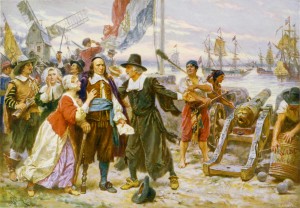
Every one of the original thirteen American colonies were founded by Englishmen, except two. The colonies of New York and New Jersey were originally Dutch colonies in the New World and the central character in the story of how they came to become English domains is a rough man named Peg-Leg Pete. Well, his real name was Peter Stuyvesant but I like to call him Peg-Leg Pete because he had a peg-leg due to an injury sustained fighting the Spanish in the West Indies. Stuyvesant was the wooden-legged governor of the Dutch colony of New Amsterdam. The Dutch had established the settlement in 1626 at the mouth of the Hudson River. They had, according to legend, bought the island of Manhattan from local Native Americans for trinkets worth about $25.
During the 17th Century, the Dutch Republic was the one of the richest nations in the world. They competed with the English for domination of maritime trade. The 17th Century was a turbulent century (aren’t they all). The Dutch were involved in the Thirty Years War and the English were dealing with problems at home, fighting the English Civil War. When the English government had been settled and the Dutch had won the Thirty Years War, the two rivals were set to begin the competition for world trade in earnest. This rivalry soon boiled over into warfare between the two countries on the high seas. The first Anglo-Dutch War was fought from 1652-1654. Sporadic wars and conflicts continued between the Dutch Republic and England until 1674. It was in this environment of trade hostility between two seafaring nations, that the attack on New Amsterdam was set.
The English attack on Stuyvesant’s New Amsterdam preceded the Second Anglo-Dutch War of 1665-1667 by about half a year. In September, 1664, the English fleet sailed to the port of New Amsterdam and demanded its surrender. This incident no doubt had much to do with the Second Anglo-Dutch War. Peg-Leg Pete desperately wanted to give the English a fight. He was a proud, tough and harsh man and an authoritarian governor. Because of his unpopularity, the Dutch settlers refused to support his plan to defend the port against the English. They wanted peace, even if that meant surrender. Stuyvesant was thereby forced by the intimidating guns of the English fleet and the desires of his own people to hand over the settlement of New Amsterdam to the English.
New Amsterdam was renamed New York, after the Duke of York, the mastermind of the attack. It was briefly recaptured by the Dutch again in 1673 during the Third Anglo-Dutch War but was quickly returned to the English. The English would remain in control of New York until the War of American Independence. No doubt, however, the Dutch heritage in New York lived on. Places like Brooklyn and Harlem have their origins in the Dutch colonization. They come from the Dutch names Breuckelen and Haarlem respectively. Even Wall Street has Dutch origins, deriving its name from the Dutch “de Waal Straat”.
The Dutch colonization in North America was relatively short-lived and minor in scale but it reminds us that our nation was a melting pot even before it was an independent nation. Alongside the Dutch and English lived French Huguenots, Germans, Irish, Swedes, Africans, and Native Americans. Peter Stuyvesant may be a side character in the greater scheme of American history but his story and the story of the Dutch colony at the Hudson Bay is an important part of our history.
